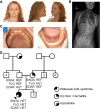Three rare disease diagnoses in one patient through exome sequencing
- PMID: 31427378
- PMCID: PMC6913146
- DOI: 10.1101/mcs.a004390
Three rare disease diagnoses in one patient through exome sequencing
Abstract
Diagnostic exome sequencing yields a single genetic diagnosis in ∼30% of cases, and according to recent studies the prevalence of identifying two genetic conditions in a single individual range between 4.6% and 7%. We present a patient diagnosed with three different rare conditions, each explained by a pathogenic variant in a different gene. A 17-yr-old female was evaluated for a history of motor and speech delay, scoliosis, distinctive craniofacial features, and dry skin in the Department of Clinical Genomics at Mayo Clinic. Her distinctive features included prominent forehead, epicanthus, depressed nasal bridge, narrow mouth, prognathism, malar flattening, and oligodontia. Family history was notable for dry skin in her mother and missing teeth in the paternal grandmother. Previous diagnostic testing was unrevealing including biochemical testing, echocardiogram, abdominal ultrasound, and electroencephalogram. Previous genetic testing included a microarray-based comparative genomic hybridization that was reported normal. Three pathogenic loss-of-function heterozygous variants were identified by exome trio sequencing, each linked to different genetic conditions: SIN3A (Witteveen-Kolk syndrome), FLG (dermatitis), and EDAR (ectodermal dysplasia). Together, these three genetic alterations could explain the patient's overall phenotype. This patient demonstrates the importance of performing a thorough curation of exome data when presented with a complex phenotype. Although phenotypic variability can explain some of these situations, the hypothesis of multiple diseases coexisting in a single patient should never be disregarded completely.
Keywords: abnormality of the eyebrow; abnormality of the eyelashes; attention deficit hyperactivity disorder; autism; central hypotonia; cervical ribs; depressed nasal bridge; dry skin; high forehead; hypodontia; joint laxity; narrow mouth; perioral eczema; prominent epicanthal folds; short stature; thickened ears; thoracic scoliosis.
© 2019 Ferrer et al.; Published by Cold Spring Harbor Laboratory Press.
Figures

References
-
- Brown SJ, Relton CL, Liao H, Zhao Y, Sandilands A, McLean WHI, Cordell HJ, Reynolds NJ. 2009. Filaggrin haploinsufficiency is highly penetrant and is associated with increased severity of eczema: further delineation of the skin phenotype in a prospective epidemiological study of 792 school children. Br J Dermatol 161: 884–889. 10.1111/j.1365-2133.2009.09339.x - DOI
-
- Coban-Akdemir Z, White JJ, Song X, Jhangiani SN, Fatih JM, Gambin T, Bayram Y, Chinn IK, Karaca E, Punetha J, et al. 2018. Identifying genes whose mutant transcripts cause dominant disease traits by potential gain-of-function alleles. Am J Hum Genet 103: 171–187. 10.1016/j.ajhg.2018.06.009 - DOI - PMC - PubMed
Publication types
MeSH terms
LinkOut - more resources
Full Text Sources
Medical
Miscellaneous
